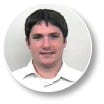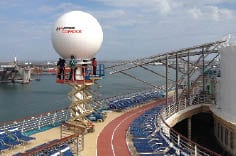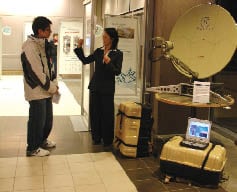Via Satellite’s 2013 Excellence Awards: The Winners
Via Satellite’s 2013 Excellence Awards salute the innovative companies, technologies, campaigns and people who’ve helped shape the success of the global satellite industry. We believe our 2013 Excellence Award Recipients are the most outstanding people and technologies in satellite and set a benchmark for what can be accomplished in this storied marketplace.
Via Satellite is well known for its Satellite Executive of the Year award which has been going strong for more than 30 years. However, with so many outstanding nominations every year, we felt the need to recognize more of the great work and talent in our industry. In a major new initiative, we have created a series of awards that cover the length and breadth of the satellite industry. These are the winners of the first edition of Via Satellite’s Excellence Awards.
Humanitarian Satellite Company of the Year: On Call Communications
 Our first ever Excellence Award winner for its humanitarian efforts goes to On Call Communications for its work in Haiti after one of the worst earthquakes in recent times hit the country in 2010.
Our first ever Excellence Award winner for its humanitarian efforts goes to On Call Communications for its work in Haiti after one of the worst earthquakes in recent times hit the country in 2010.
Jim Gilbert, CEO, On Call Communications says the company is honored to win this award, although adds that it “truly belongs to a number of individuals and companies who have given their time, equipment, and services to support our vision of improving the lives of children in Haiti.” Intelsat, which provided space capacity, was particularly involved in this project. On Call has played a key role in galvanizing the industry to provide a solution that brings better healthcare and education to the children of Haiti.
 The story starts around six years ago when Gilbert met Father Marc Boisvert who was soliciting donations for Free The Kids, Inc to support his orphanage in southern Haiti. “His vision for helping the Haitian children has grown over the years to provide a secure and caring environment for the world’s poorest of the poor and forgotten children. Father Marc and his staff houses some 450 orphans and provides meals and education for an additional 1,500,” says Gilbert.
The story starts around six years ago when Gilbert met Father Marc Boisvert who was soliciting donations for Free The Kids, Inc to support his orphanage in southern Haiti. “His vision for helping the Haitian children has grown over the years to provide a secure and caring environment for the world’s poorest of the poor and forgotten children. Father Marc and his staff houses some 450 orphans and provides meals and education for an additional 1,500,” says Gilbert.
 The opportunity for On Call Communications to make a difference in Haiti came in 2012. “They have a clinic, but their medical staff’s capabilities are limited and very basic, there is a school, but the curriculum is outdated and the staff under qualified. The most glaring problem is that they were cut off from the rest of the world. That difference would be in the form of a satellite link and a wireless network throughout the campus which would provide free voice circuits, Internet access to provide current lesson plans for the school along with HD video conferencing to be used between the clinic and teaching hospitals in the United States and abroad,” Gilbert says.
The opportunity for On Call Communications to make a difference in Haiti came in 2012. “They have a clinic, but their medical staff’s capabilities are limited and very basic, there is a school, but the curriculum is outdated and the staff under qualified. The most glaring problem is that they were cut off from the rest of the world. That difference would be in the form of a satellite link and a wireless network throughout the campus which would provide free voice circuits, Internet access to provide current lesson plans for the school along with HD video conferencing to be used between the clinic and teaching hospitals in the United States and abroad,” Gilbert says.
 When asked about an anecdote from his time in Haiti, Gilbert says, “The memory that sticks out the most for me was the little ones at the orphanage. They locals call them ‘the watermelon kids’ because the color of their school uniforms. When I travelled over to their school area, I was engulfed by about 50 of the littlest ones at the orphanage. They all just wanted interaction and lined up to be hugged. I’m hoping that what we’re doing will make a difference in their lives.”
When asked about an anecdote from his time in Haiti, Gilbert says, “The memory that sticks out the most for me was the little ones at the orphanage. They locals call them ‘the watermelon kids’ because the color of their school uniforms. When I travelled over to their school area, I was engulfed by about 50 of the littlest ones at the orphanage. They all just wanted interaction and lined up to be hugged. I’m hoping that what we’re doing will make a difference in their lives.”
Woman in Technology: Amiee Chan
Norsat International’s CEO Amiee Chan is an inspiring example to young women in the satellite industry, and a worthy winner of Via Satellite’s Woman in Technology Excellence award. She says it is a “tremendous honor” to win and that this award was of particular delight because it recognized her experience in technology rather than just her business and leadership skills which have bought other awards. In terms of her career highlights so far, Chan says that leading Norsat from near insolvency in 2006 to the “thriving” company it is today is something she incredibly proud of.
“When I became CEO, Norsat was losing millions of dollars per year, and had significant debt, so it was a sink or swim situation for me as a leader. I had to turn the company around, and so I made a lot of tough decisions to reduce operating expenses. Enacting major change is never easy and I faced a lot of opposition, but it has certainly been worth it,” she recalls. “Another highlight would be our acquisition of Sinclair Technologies in 2011. Our revenues have basically doubled; it’s been so gratifying to see this success against the backdrop of our past.”
In terms of getting more women into the space industry, Chan says, “I think people make assumptions because women are underrepresented in these fields. It’s the same for the underrepresentation of women in the boardroom. I know that attitudes and stereotypes will only change over time as more women take on roles of increased responsibility, profile and leadership,” she says. “I have high hopes for the women of the future, because young women now have more strong female role models than ever, and I know that this will only encourage them to pursue careers in non-traditional fields. I also like to keep in mind that success speaks for itself. If you can work hard and get results, you will always command respect, so I try to focus on getting the job done and ignoring the rest. As people see how great women are as engineers, scientists and leaders, stereotypes will melt away.”
Chan volunteers as a mentor for the Ms. Infinity Program with Women in Science and Technology, which is devoted to encouraging women to develop careers in science and technology. She also serves on the National Advisory Committee on Girls and Science, Technology, Engineering and Mathematics (STEM), which introduces girls of all ages to opportunities in these fields. And she also participate often in speaking engagements for young people at various local schools and universities.
“Don’t be afraid to take risks!” is her advice for young women starting out today. “Early in your career it can be difficult to have the courage to make decisions when the stakes are high, especially when you see few other women doing so. But when you’ve done the research and you’re passionate about a project, you just need to dive in head first. There is no better teacher than experience, and even when I’ve failed, that experience has driven me forward to better things,” she says. “I hope my experience can give young people the courage to take career risks, and achieve great things.”
Lifetime Achievement Award: Ali Ebadi
Ali Ebadi, Measat’s SVP, Space Systems Development, is one of the most recognizable faces in the space industry. It is for his role in developing the space industry in Malaysia that Ebadi has been selected as Via Satellite’s first ever Lifetime Achievement Award winner.
Measat has gone from launching its first satellite back in the late 1990s to an operator that is now present in many markets across Asia, as well as having an expanded African play.
Ebadi’s career spans many decades, but talking about the highlights, he goes back to 1991 to remember the challenges in setting up Malaysia’s first satellite system.
“At this time, I was responsible for the technical aspects of the development of Measat from building the team to training Malaysian engineers to seeing through the successful launch of Malaysia’s first satellite. I was also responsible for setting up Measat satellite operation stations in Langkawi and later the Measat Teleport and Broadcasting Center located outside of Kuala Lumpur, which provides the technical hub for the Measat satellite system today,” he says.
One of the other highlights for Ebadi was working closely with the government of Malaysia to file and coordinate several strategic orbital positions with the ITU for the future Measat system. Ebadi says these filings have allowed the company to expand from an operator focused on supporting the ICT requirements of the country, to a global satellite operator with a footprint covering more than 150 countries representing 80 percent of the world’s population.
Ebadi is now focused on nurturing the next generation of talent for the space industry in Malaysia. “This includes introducing satellite communication subjects (and setting up satellite communications laboratories) at two of Malaysia’s leading universities, Universiti [sic] Malaya and Universiti [sic] Teknologi [sic] MARA Shah Alam. It also includes my work at Measat aimed at furthering the professional and personal development of our engineers,” he says.
With a career that has been at the center of Malaysia developing a space capability, Ebadi says his key learning has been “to seek opportunities to work in a cooperative manner, and seek win-win opportunities.”
“I remember the first frequency coordination meeting I attended in 1992, from which I came back without any progress. At that time, Measat’s prime orbital slot of 91.5 degrees east seemed almost impossible to coordinate,” he says. “Gradually, I learned to be more realistic in terms of actual usage of satellite parameters and what we try to obtain during coordination procedures. Concurrently, I learned to have a certain degree of flexibility in the design of satellite payloads and antenna to avoid potential incompatibility with adjacent satellites,” he adds.
From his lifetime experience in the industry, he advises young satellite engineers “to first get an overall view of the satellite industry, chose your area of interest, and then see the company’s goals in their short and long term plans. Aim for the best and never be afraid of failure. Challenges can be overcome, and once you do, it makes you stronger and a better engineer and person.”

Young Engineer Award: Colin Marker
Colin Marker, engineering project manager for spacecraft bus at Boeing Satellite Systems is our youngest winner taking home the Young Engineer Excellence award. Marker said the announcement came as a “complete surprise.”
“I am honored to be included in a group of such high achievers, particularly since I know the amount of amazing talent we have just at Boeing, and this award extends to the entire industry. I hope to be able to live up to the title as I continue forward in my career, to age 30 and beyond,” he says.
Marker cites his biggest achievement as obtaining his current positions as a spacecraft bus lead after only six years at Boeing. He believes he was able to get to this point in part because he was afforded an opportunity to experience a wide breadth of the satellite industry.
Marker was initially hired into a rotation program where he experienced mission operations, financial operations, systems engineering, unit area manufacturing, and software development. “In my time, I have worked closely with customers, program managers, VPs, subject matter experts, technicians, and new hires. These experiences allowed me to continually challenge myself and grow as a young engineer,” he says.
One of the big issues for the satellite industry currently is attracting new talent like Marker. He cites an early childhood passion as one of the reasons why he entered the aerospace field. “Growing up in Houston, I have fond memories of climbing through the Johnson Space Center shuttle mockup and the huge Saturn 5 rocket. My love of space and planes led me to obtaining a bachelor’s degree in aerospace engineering. After graduating, I initially worked for an oil and gas company in Texas but soon chose to pursue a career in aerospace instead, which was my original area of interest. I realized that it is important for employees to have passion in the work they do. I left that job to take the rotation program at Boeing in California. I often walk through the high bay and remind myself that very few people get to work on things that go into space,” he says.
Marker admits that it is a challenge to attract young people to the industry, and says media coverage in recent times has not helped the space industry, although he is encouraged by the recent coverage of the Mars Curiosity Rover. “Baby boomers are beginning to exit the work force. The hardest part is getting in the door. Today the space industry is not as sexy or popular as it was during the space race. Shuttle launches used to be shown on the major news networks and the entire country celebrated at the giant scientific leaps made by mankind. Now, media tends to focus on failures,” he says. “I was encouraged by the press coverage on the Mars Curiosity rover, which is a good start for positive media coverage. It is up to the engineering community to promote through science and math volunteerism to encourage the next generation.”
With Marker yet to hit 30 and already a key part of Boeing’s space programs, the world is his oyster. In terms of what he hopes to achieve next, he says, “My current position as bus lead is challenging and has exposed me to half the spacecraft. In my next position, I plan to focus on payload design and manufacturing to prepare myself for a future program manager assignment.”

Vertical Impact – Maritime Award: Harris CapRock
Harris CapRock wins our Vertical Impact Excellence award for maritime, having had a strong year across this vibrant marketplace. “Being recognized as part of the inaugural Excellence Award winners is a huge honor for our maritime team and for our entire business at Harris CapRock,” says Rick Simonian, president, maritime solutions, Harris CapRock Communications.
Certainly, one of the most eye-popping deals in this vertical involved Royal Caribbean, one of the most globally recognized cruise ship operators, which has been working to provide on-board connectivity.
Harris CapRock hit a major milestone within its maritime business when it completed the fleet transition for Royal Caribbean. The company installed 89 of its SpaceTrack stabilized antenna systems and removed more than 50 legacy antenna systems on 33 of Royal Caribbean’s vessels in less than nine months. Deployments and installations spanned across more than 16 ports in the United States, Europe, and Asia Pacific and in most cases, four or five lifts were done in a single turn-around day with all voice and data services converted to Harris CapRock infrastructure before departing port.
 However, this was just the beginning. A further win with cruise ship operator Carnival Cruises, cemented Harris CapRock’s position as a major player in the maritime and nascent cruise ship sector. “The agreement is the largest of its kind in scale, with service to 103 vessels, and represents a unique commitment across all of the Carnival brands to improve the level and quality of communication service for guests and crew,” says Simonian. “The ships are already transitioning into our network, and during Q4 of 2013 we’ll be transitioning one ship a day.”
However, this was just the beginning. A further win with cruise ship operator Carnival Cruises, cemented Harris CapRock’s position as a major player in the maritime and nascent cruise ship sector. “The agreement is the largest of its kind in scale, with service to 103 vessels, and represents a unique commitment across all of the Carnival brands to improve the level and quality of communication service for guests and crew,” says Simonian. “The ships are already transitioning into our network, and during Q4 of 2013 we’ll be transitioning one ship a day.”
Simonian admits that the consistent request from every segment of the maritime market has been for more bandwidth with better coverage at a lower cost. “The migration from L-band service to VSAT continues to accelerate and we are finding that even ships with a crew of 20 or 30 are asking for bandwidth levels over 512 Kbps. Three years ago they would have been satisfied with a 64 Kbps service, so this demonstrates the trend for constant connectivity and an exceptional amount of capacity over the major shipping routes. Passenger vessels have moved from a typical 1-2 Mbps to double or triple that level in the past two years,” he says. “One of the roles that Harris CapRock plays in this market is to take our global forecast of the maritime demand and help shape the solutions that the satellite operators are designing.”
The company currently services more than 400 commercial shipping and supply vessels and Simonian says they would like to see that continue to grow globally. “Leveraging our scale across the maritime market and across Harris’ communications resources and expertise, creates an organization with unsurpassed satellite and terrestrial network capabilities, end-to-end service offerings and an experienced service team to provide customers with unsurpassed global field support,” he says.
 Social Media Company of the Year: iDirect
Social Media Company of the Year: iDirect
For its creative social media efforts, iDirect was selected as Social Media Company of the Year. Toni Lee Rudnicki, iDirect’s CMO, described social media “as a key element of our strategy to provide industry thought leadership.”
iDirect has implemented innovative strategies to promote and participate in different social media outlets. For example, it produced two viral videos for its new X7 remote. The goal of the videos was to implement the capabilities of the X7 within a narrative that could explain the features at a high level.
The campaign consisted of two parody videos. The first was “Byte rider,” which played off of the movie “Knight Rider.” The other was “Faster, Better, Stronger,” which was inspired by the “Six Million Dollar Man.”

iDirect used both videos to show parallels to the movie and the TV show it spoofed, while integrating the remote’s capabilities and functionality. Since the initial release, the X7 landing page has seen an extensive amount of traffic. From October 2012 through August 2013, the X7 landing page received 8,677 views.
Rudnicki admits the company sees social media as an important channel for dialogue. “It’s a way to engage the industry in a valuable conversation, sharing our expertise and drawing insights from our partners and industry experts. Social media is an integral part of our overarching communications strategy. It is instrumental to reaching a very diverse audience, across the entire satellite industry and well as to end user markets,” he says. “iDirect was one of the first companies in the industry to adopt social media. We leverage this network to reach our global audience effectively, .”
The company is currently expanding its social media program, and aims to use it as a way of focusing on issues that are key to satellite’s future such as High Throughput Satellites (HTS) and mobility. “We need to tap a broad range of social media channels, understand their unique advantages and go to market with a comprehensive communications strategy. This is critical to our business strategy because in the satellite industry there is an overwhelming need for education,” Rudnicki says.
 Technology Company of the Year: iDirect
Technology Company of the Year: iDirect
In one of the most fiercely contested Excellence Awards, iDirect beat all comers to win this much-coveted award. David Bettinger, the company’s CTO said they were “thrilled” to win.
iDirect has had a busy 2013. To start, it expanded its platform capabilities through what Bettinger describes as an “ambitious development” plan. The company has launched the X7 remote, the first in its next-generation family of remotes, which is built on an entirely new multi-core hardware for higher throughput. It has also introduced an upgrade to its Evolution operating system with iDX 3.2. “With the X7, service providers can introduce significantly faster data rates to answer escalating end user demand for high-speed bandwidth. iDX 3.2 delivers efficiency gains through Adaptive TDMA, waveform enhancements, roll off improvements and faster remote acquisition,” says Bettinger.
The company is also nearing the end of the development of its new product line, Velocity, which is designed to provide seamless mobility and high performance in a multi-spot beam HTS environment. Velocity will be deployed for Inmarsat’s Global Xpress HTS service, which goes live early in 2014.
iDirect has positioned itself as one of the technology leaders in the satellite industry. In terms of what it has coming up in 2014, Bettinger adds, “We will continue to develop our core platform for greater scale, throughput and efficiency. One significant area of focus will be developing our next-generation Network Management System. This will be a critical expansion of platform – one that will enable our partners to reach new levels of business and network performance, while giving them innovative tools to continually deliver differentiated value to their customers.”
iDirect is committed to enhancing its already diverse remote portfolio and introducing major processing gains as well as terminals that will be smaller, more cost-effective, easier to install and quicker to deploy. They will also become more integrated, as antenna manufacturers begin to build all the infrastructure and functionality into a more contained unit.
Bettinger says he sees a “tremendous opportunity” for the company in many HTS initiatives throughout the industry, where iDirect is looking to play a key role. However, with so much happening right now, he believes we are in midst of a “defining time for iDirect and the industry.”
“The demand for ubiquitous broadband connectivity will continue to explode,” Bettinger says. “Today, networks must converge voice, data and video on one platform, support any application, reach any geography and deliver unified global service plans. That can only be achieved with significant involvement from the satellite industry. VSAT is essential to the connectivity solutions of the future – not as a standalone network, not as a hybrid network, but a full element of a converged network. HTS represents a huge milestone in the satellite’s transformation to becoming a more mature industry. And as we move into next year and beyond, the VSAT industry is poised to break out of its niche market and enter into a new era.”
He continues, “HTS paves the way, but we need to do more. We need even greater advances in performance and economics. And we need to focus on making satellite integrate seamless with core networks and meeting today’s demands for mainstream usability.”
 Vertical Impact – Oil & Gas Award: Hermes Datacomms
Vertical Impact – Oil & Gas Award: Hermes Datacomms
The oil and gas sector has long been targeted by companies in the satellite industry, but Hermes Datacomms stood out among them to become the recipient of our Oil & Gas Vertical Impact Award. Bill Green, global account director, Hermes Datacomms, says the company is “delighted to have received the award and, more importantly, be acknowledged as making a significant impact in this challenging vertical.”
Hermes Datacomms has been particularly strong in developing its footprint in Africa, launching a satellite platform over the whole continent aimed at providing “consistent quality of service and user experience, allowing both producers and services companies to keep drilling,” Green says. In April this year, the company signed a major deal with Tullow Oil, an oil company with an ever-expanding presence in Africa. The 24-month deal sees the company use its pan-African satellite platform to provide a connection from Tullow Oil’s data center in London to its Ethiopian office Addis Ababa, extending core services to the continent and growing current services in Kenya.
 But Hermes Datacomms’ ambitions don’t stop there. In South East Asia, the company has been building its team in the region and understanding the nuance of the regulatory processes as well as the best-fit technology. “We’ve delivered to new customers in the region and have used our enhanced knowledge to deliver service for current customers in new territories,” says Green. Earlier this year, the company also announced it was now providing VSAT services in Yangon, Myanmar for a global oilfield service group.
But Hermes Datacomms’ ambitions don’t stop there. In South East Asia, the company has been building its team in the region and understanding the nuance of the regulatory processes as well as the best-fit technology. “We’ve delivered to new customers in the region and have used our enhanced knowledge to deliver service for current customers in new territories,” says Green. Earlier this year, the company also announced it was now providing VSAT services in Yangon, Myanmar for a global oilfield service group.
As part of this initiative the company has signed customers to its SPX service. “We call the management of services provided by a number of service providers by a single, trusted partner SPX (Service Provider X). Within this function, customers have access to Hermes’ recent and current experience of managing global networks on behalf of their customers (for example a 31 x site global network for a large EPC company, encompassing VSAT, MPLS, Leased Line and Internet),” says Green.
 Vertical Impact – Broadcast Award: ViaSat
Vertical Impact – Broadcast Award: ViaSat
ViaSat has been at the forefront of technology development in the satellite industry, particularly around its ViaSat 1 satellite. It is this satellite that has enabled the operator to bring its Exede live news and events service, and provide newsgathering operations tools for broadcasting. It is through these initiatives that ViaSat has won our first ever Excellence Vertical impact award for broadcasting.
“We thought we had new service that could be a great new tool for broadcasters, so we appreciate this recognition. It’s an honor to be chosen for the award,” says Stefan Jucken, director, strategic business development, ViaSat.
The Exede news service is a sign of the company’s innovation in a new market. The service leverages the 140 Gbps ViaSat 1 satellite to deliver HD-quality video over an 8 Mbps uplink plus a broadband downlink to increase productivity and interaction between field teams and production studios. Jucken says the service enables traditional news teams to enrich stories, incorporating images and footage received from the station and upload their packages. Social media feedback can be taken into the field to interact with the reporter, which adds to the news production experience.
“A new breed of ‘mobile weather vehicles’ enables meteorologists to receive weather data from the station and weather centers to deliver the complete local and national report without needing to ‘hand it back to the station.’ Live event producers can stream concerts, local sporting events, and conferences in HD to serve wider audiences, entertaining and educating anyone with an Internet connection,” he adds.
Jucken is optimistic for 2014, and that ViaSat will be able to target new elements of the broadcast market. “We see strong market expansion in 2014 for the Exede live news and events service. Our first applications have been with traditional news organizations; for these companies, the innovative satellite offering represents a displacement and/or augmentation strategy and that limits the market opportunity.
The real potential for market expansion is in the largely unserved live entertainment streaming, which we expect to be an exciting arena in 2014. The next level is to apply the high-capacity Ka-band approach to content distribution as well. The granularity of the spot beam system allows for highly-efficient local content distribution,” he says.
 Vertical Impact – Military Award: Satcom Direct
Vertical Impact – Military Award: Satcom Direct
SatCom Direct is a deserved winner of our Vertical Impact for Military Excellence Award. The company has had a strong 2013 in the military arena and last May, its military government team, secured a contract to become DISA/DITCO’s single FCSA provider for aeronautical satcom services for the next five years. This was a major deal for the company worth around $220 million.
“We were able to demonstrate to the government that it was Satcom Direct which had been the critical delivery agent behind the scenes as a subcontractor for the previous 10-year period,” says David Greenhill, president, Satcom Direct. “We are now able to deliver the same high quality of service under a new cost structure as the prime. We have to credit our in-house engineering team for developing our portfolio of enhanced products that the user counts on during their day-to-day mission operations.”
 The company is looking forward to working with the likes of ViaSat, Immarsat and Iridium to provide its tools and applications. “Our close partnership with them allows us to deliver an entirely unique capability.
The company is looking forward to working with the likes of ViaSat, Immarsat and Iridium to provide its tools and applications. “Our close partnership with them allows us to deliver an entirely unique capability.
Over the next two years, we will take this capability to the next level by providing satellite operators and network providers with a new and improved set of mission-focused tools and applications,” says Greenhill.
In terms of the trends in the military/government business, Greenhill stresses that lowest cost does not always mean best value. “I think that it is important for the government to consider the contractor’s demonstrated ability to deliver quality satellite communication services at cost-effective prices. Selecting a provider solely on the basis of cost (via LPTA) means that the user could suffer significant degradation of capability if that provider does not deliver a product with enhanced, mission-oriented features. There should be more careful thought as to what ‘best value’ means to the end user,” he adds.
 Lead Sponsor Via Satellite Excellence Awards – Gilat Satellite Networks
Lead Sponsor Via Satellite Excellence Awards – Gilat Satellite Networks
David Leichner, VP of corporate marketing, Gilat Satellite Networks, says the company is “proud” to be the premier sponsor of the first Via Satellite Excellence Awards. With more than 25 years of experience, Leichner says the company is uniquely positioned to be a sponsor of the awards.
Gilat has had a busy year. It has overseen the launch of the SkyEdge II-c platform in its commercial division as part of its move to maximize the potential of the growing market for broadband Internet access.
“The SkyEdge II-c platform only requires a minimal initial investment but has the ability to scale. It is based on a rapid and efficient hub assembly and installation and self-install CPE terminals,” says Leichner.
“It enables customized value-add services and usage plans for ISPs, flexible business models for operators and VNOs and better web experience with patented HTTP acceleration for consumers. It also comes with an integrated and automated network management system for streamlined network management.”
In the defense arena, Gilat has launched the Ka Matchbox Mini Block Upconverter, the next evolution in the Wavestream Matchbox series. “The Mini product retains all the features and improves on the performance of its Ka-band predecessor while being one-third the size, one-third the weight and twice the linear output power,” says Leichner.
As one of the highlights for the company in 2013, Leichner points to Gilat’s implementation for NBN Co in Australia with more than 42,000 sites now being installed. “We are confident that the installation of the full 48,000 sites will be completed ahead of schedule by mid-2014. The Australian government has shown interest in continuing to provide support for NBN services going forward. While we do not have any commitment yet, there is a possibility that they will extend the service,” he adds.
With much talk about High Throughput Satellites (HTS), Leichner is optimistic Gilat will be able to ride this wave in 2014. “We continue to work on broadband Internet access contracts and are confident we will close additional deals in this segment. We expect to see more deals in the mobile satellite broadcasting and HTS market and expansion to new applications and markets. We continue to work hard to increase our strong presence in South America, Asia Pacific and Euro Asia, and to increase our penetration in Africa,” he says. VS
